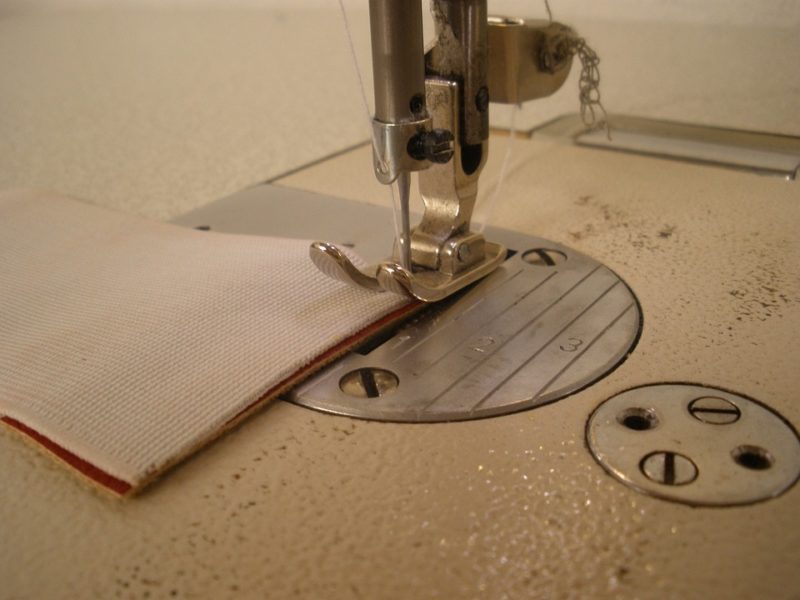The answer to what is interfacing in sewing is that it’s a material you’ll use to stiffen your project. There are different types of interfacing as well, so we will talk about them in this article. You will even learn if they matter in the first place or if you can skip using interfacing when sewing.
Speaking of sewing, you might be interested in learning about sewing machines. For example, how does a sewing machine work? It can be a helpful read since sewing by hand can take time and effort, and understanding machine sewing will allow you to learn it quicker.

A Guide To What Is Interfacing In Sewing
The interfacing in sewing refers to a fabric that gives structure to the sewing project. There are different types and materials of interfacing, but they all aim to stiffen the parts of the project where you need shape or stability. For example, you can usually encounter interfacing on pockets and collars since they need shape and firmness for aesthetics and longevity.
What Are The Different Types Of Interfacing?
Fusible interfacing vs non-fusible interfacing
From the name itself, the fusible interfacing can adhere to the fabric on its own. This is possible because it has an adhesive on the back that you can activate with a steam iron. On the other hand, some interfacing types are non-fusible, so you’ll need to sew them in place.
Double-sided fusible interfacing
Besides fusible and non-fusible interfacing, you’ll also find double-sided fusible interfacing in the market. When applying it to a fabric, you can use both sides, which makes this type of interfacing suitable when using appliques for your project. In addition, the double-sided feature should keep the edges from fraying.
Woven interfacing vs non-woven interfacing
The interfacing can either be woven or non-woven, and you can easily differentiate them visually. Of course, there is a weave pattern on the woven interfacing, while the non-woven interfacing looks more like paper since it is bonded and not woven. Furthermore, note that you must always cut with the grain of the woven interfacing because it has no stretch.
Knit interfacing
If you need interfacing that has a bit of stretch, you can use knit interfacing. The slight stretch is helpful for projects that will be used often to prevent wrinkling. There is also fusible knit interfacing that is often used for woven garments.
What Are Interfacing Weights?
You can categorize interfacing not just with the type of material but also with their weights. The weight of the interfacing matters because you don’t want it to be heavier than the project’s material. Otherwise, the finish will drape because of the resulting rigidity.
The interfacing weights are featherweight, medium weight, and heavyweight. A featherweight interfacing is suitable for delicate fabrics, while a medium weight interfacing is a safe choice for most projects that need stability. And as for the heavyweight interfacing, it’s often used for projects that need to stand alone, such as hats and purses.
What Is Interfacing In Sewing Used For?
- Interfacing adds stability or thickness to a flimsy project
- Having interfacing can make the material look neater and finished
- Embroidered projects can benefit from interfacing to keep them from draping
- Interfacing can provide more structure and weight on quilted items
- Interfacing gives shape and stability to garments and bags
Do You Need Interfacing When Sewing?
Interfacing is vital when sewing because it gives shape and structure to the project. Even if you’re using a naturally stiff material, strategic placements of interfacing will prevent distortion and keep it visually appealing and durable. Thus, one can say that interfacing is a necessary reinforcement to any sewing project.
How Do You Use An Interface For Sewing?
Using an interface for sewing will depend on the type you have. The easiest one to apply is fusible interfacing:
- Identify the adhesive side of the interfacing, usually shiny and raised
- Cut the shape and size you need for the project, but remember that woven interfacing is cut with the grain and knit interfacing crosswise
- Place the main fabric wrong side up on an ironing board and the fusible interfacing’s adhesive side over it
- Cover the two with a damp press cloth and press the iron for 10 to 15 seconds over it without gliding
- Check if the interfacing has been attached securely and repeat pressing if needed
- Leave the project to dry and cool down to prevent distortion
What Happens If I Don’t Use Interfacing?
You can opt to skip interfacing when sewing, but it’s not recommended. Most projects such as garments will need structure or they’ll wrinkle or hang, which is unpleasant visually. Even other sewing projects such as purses and hats won’t look good since they would be flimsy without the shape from the interfacing.
Conclusion
Did this article answer your question? To recap what is interfacing in sewing, it refers to a material that adds structure, shape, and stability to the project. It can be fusible, non-fusible, woven, non-woven, or even knit.
You can choose not to use interfacing in sewing, but the finish won’t be as durable and visually appealing. We hope this was a helpful read, and if you have other sewing-related questions, try browsing our blog. For example, what is a serger sewing machine, and do you need it like you need interfacing when sewing projects?

Thank you so much for the detail description. Just what I was looking for.